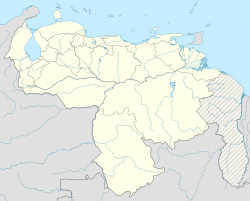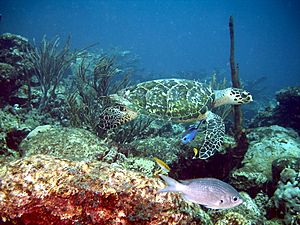Tucacas facts for kids
Quick facts for kids
Tucacas
|
|
|---|---|
Tucacas is a lively coastal town in northern Venezuela. It is located in the state of Falcón. This town is famous for its beautiful beaches. It is also a gateway to the amazing Morrocoy National Park.
Contents
Geography of Tucacas
Tucacas is surrounded by two rivers. This made it a bit tricky to reach from inland Venezuela a long time ago. The town is very close to sea level. It sits at an elevation of just 1 meter (about 3 feet).
History of Tucacas
In 1693, a group of Jewish people from Livorno (Leghorn) in Italy moved to Tucacas from Curaçao. When they settled there, Tucacas became a busy trading center. These settlers built houses and raised cattle. They even built a fortress and a synagogue (a Jewish house of worship).
They started buying cocoa beans and tobacco from inside Venezuela. Mule trains carrying cocoa from places like New Kingdom of Granada (now Colombia) and Quito (now Ecuador) would arrive in Tucacas. They sold their goods to the settlers. In return, they bought textiles and other European items.
Spanish forces tried to attack the settlement. But they failed. This was because Dutch naval units protected the area. The local Venezuelan people also helped defend it. The settlers themselves fought bravely. This Dutch area was led by Jorge Christian, Marquis of Tucacas. Samuel Gradis Gabai was also a leader. He was called Señor de Las Tucacas. Samuel was also the head of the Jewish community.
Spanish leaders in the area worked with the settlers. They saw them as a way to export goods. They also provided much-needed European products. The Spanish fleet could not meet the needs of all its colonies in America.
Changes in Government Control
At the end of 1717, the province of Venezuela became part of the Viceroyalty of New Granada. This large area also included what is now Colombia and Ecuador. The Viceroy, Jorge de Villalonga, decided to take control of Tucacas. This was due to new rules from Spain.
Pedro Jose de Olivarriaga was put in charge of stopping the trading activities in Tucacas. With special army units and 40 ships, he attacked the town in 1720. The town was captured. According to people who saw it, the synagogue was destroyed. The settlers burned their own houses. Then, they left for Curaçao.
Tucacas and Venezuelan Independence
In the 1800s, the port of Tucacas was used to export copper. This copper came from the Aroa mines. The wealthy Bolívar family owned these mines for a long time. This was from the colonial era until the 1830s. Simón Bolívar rented the mines to a British company in 1824. After Bolívar passed away, his sisters inherited the mines. They sold them to the British.
At first, the copper ore was moved by river. Later, a narrow-gauge railway was built. It went from Aroa to Tucacas. Some say this was the first railway in Venezuela. In 1924, the Bolivar Railway Company Limited merged with another railway company. This British company was part of a group that owned the copper mines.
Local Economy and Tourism
The economy of Tucacas is mostly based on tourism. Many people visit for its beautiful beaches and access to the national park.
Getting Around Tucacas
Tucacas is mentioned as a station on the national railway network. However, there is no train station for passengers in Tucacas. The railway is used to transport raw materials for industries.
There are regular bus services to and from nearby cities. These include Puerto Cabello, Valencia, Barquisimeto, and Coro. Buses also connect to most important places in the region.
You can find fuel (gas and diesel) available 24/7. There are also repair shops, tow services, and traffic police. For those on the water, boats are available for rent. Taxi boats can take you to different spots. Marine fuel is available from 6 AM to 6 PM. There are also shipyards and stores for boat parts. Major repair services for boats are also offered.
You can rent scooters and personal watercraft. However, there are no car rentals directly in town. Tucacas is also listed as a destination on Conviasa's website.
See also
 In Spanish: Tucacas para niños
In Spanish: Tucacas para niños



